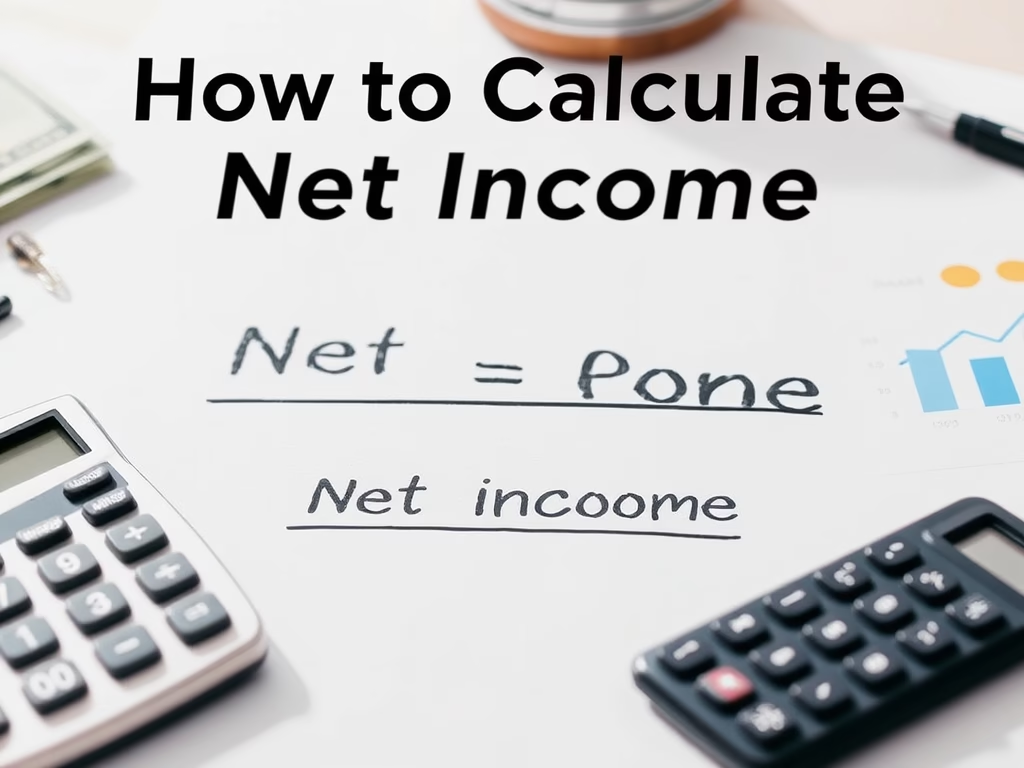Discover the ultimate guide to calculate net income. Learn what net income is, why it matters, and how to compute it step-by-step. Explore examples, common pitfalls, and tools to master this crucial financial metric for businesses and freelancers alike. Uncover the true bottom line of profitability!
Decoding Net Income: Your Ultimate Guide to Calculating Profit’s Bottom Line
Net income is the heartbeat of financial success—a number that tells you what’s left after the dust of revenue and expenses settles. Whether you’re a freelancer tracking gig earnings, a small business owner balancing the books, or an investor sizing up a company, knowing how to calculate net income is key.
It’s not just about profit; it’s about understanding what a business truly earns and what it can do next. Let’s dive into everything about net income—how to compute it, why it matters, and how it shapes financial stories.
What Is Net Income?
Net income, often called “the bottom line,” is the profit a business keeps after subtracting all expenses, taxes, and costs from its total revenue. It’s the final tally of financial performance over a period—say, a month, quarter, or year. Unlike gross profit (revenue minus direct costs), net income accounts for everything: operating expenses, interest, taxes, and more. It’s the money that’s truly yours to reinvest, distribute, or save.
Think of it as the prize after a race—revenue is the starting line, expenses are the hurdles, and net income is what you carry across the finish.
Why Net Income Is a Big Deal
Net income is more than a number—it’s a signal. Positive net income shows a business is thriving, covering costs and then some. For a café owner, it might mean extra cash for a new espresso machine. For a corporation, it’s fuel for dividends or expansion. Negative net income—a loss—flags trouble, like rising costs outpacing sales.
It’s a universal yardstick. Investors use it to gauge profitability, lenders check it for loanworthiness, and managers rely on it to steer strategy. It’s also the root of retained earnings, linking it to long-term growth.
The Formula: How to Calculate Net Income
Calculating net income is like peeling an onion—layer by layer, you strip away costs to reveal the core. Here’s the basic equation:
Net Income = Total Revenue – Total Expenses
But “total expenses” has layers. Let’s refine it:
Net Income = Total Revenue – (Cost of Goods Sold + Operating Expenses + Interest + Taxes)
- Total Revenue: All income from sales, services, or other sources (e.g., rental income).
- Cost of Goods Sold (COGS): Direct costs of producing goods or services (e.g., materials, labor).
- Operating Expenses: Overhead like rent, utilities, salaries, marketing.
- Interest: Costs of borrowed money (e.g., loan interest).
- Taxes: Income tax owed to the government.
Step-by-Step Calculation
Here’s how to do it:
- Sum Your Revenue
Add up all income streams for the period. For a shop, it’s sales; for a freelancer, it’s fees. - Subtract COGS
Deduct direct costs tied to production. This gives gross profit. - Subtract Operating Expenses
Take away indirect costs—rent, payroll, ads. Now you’ve got operating income. - Subtract Interest and Taxes
Remove loan interest and tax obligations. What’s left is net income.
A Unique Example: Riverstone Crafts
Meet Javier, who runs Riverstone Crafts, a handmade jewelry business. It’s 2025, and he’s calculating net income for the year. Here’s his data:
- Revenue: $25,000 (sales of necklaces, bracelets)
- COGS: $8,000 (beads, wires, packaging)
- Operating Expenses: $6,000 (rent $2,000, utilities $1,000, marketing $3,000)
- Interest: $500 (loan for a worktable)
- Taxes: $2,500 (income tax)
Calculation:
- Revenue: $25,000
- Minus COGS: $25,000 – $8,000 = $17,000 (Gross Profit)
- Minus Operating Expenses: $17,000 – $6,000 = $11,000 (Operating Income)
- Minus Interest: $11,000 – $500 = $10,500
- Minus Taxes: $10,500 – $2,500 = $8,000
Javier’s net income is $8,000—his profit for 2025. He could reinvest it in gemstones or take a well-earned bonus.
Variations and Nuances
Net income isn’t one-size-fits-all:
- Positive vs. Negative: $8,000 is a win; -$2,000 (if expenses hit $27,000) is a loss.
- Before vs. After Tax: Some contexts use “net income before tax” ($10,500 for Javier) for analysis.
- Adjustments: One-time events (e.g., selling old equipment for $1,000) might boost revenue, skewing the norm. Exclude these for “adjusted net income” if needed.
Where to Find the Numbers
- Revenue: Sales records, invoices, or bank deposits.
- COGS: Inventory logs, supplier bills.
- Operating Expenses: Receipts, payroll, utility bills.
- Interest: Loan statements.
- Taxes: Tax filings or estimates.
Start with a trial balance to ensure your ledger’s accurate, then pull these figures.
Beyond the Math: The Bigger Picture
Net income reflects choices. Javier could cut marketing to $1,000, boosting net income to $10,000—but would sales drop? A big corporation might show a loss from heavy R&D, betting on future wins. It’s a balance of now and later.
It’s also dynamic. A seasonal spike (holiday sales) or a cost surge (new hire) shifts it. Compare it period-to-period to spot trends—did Javier’s $8,000 beat last year’s $6,000?
Common Pitfalls and Fixes
- Missing Revenue: Forgot a $200 craft fair sale? Add it.
- Overstated Expenses: Double-counted rent? Fix it.
- Timing Errors: December sales in January’s books? Align them to the right period.
Tools to Nail It
Pen and paper work, but software like QuickBooks or Wave tallies it fast. Spreadsheets with formulas (e.g., =Revenue-COGS-OpEx-Interest-Taxes) keep it manual yet slick. Understanding the process trumps reliance on tech.
Net Income in Action
For Javier, $8,000 might fund a website upgrade. For a public company, it feeds dividends or debt reduction. On the income statement, it’s the bottom line; on the balance sheet, it flows into retained earnings—bridging past profit to future potential.
Limitations to Know
Net income isn’t cash—it’s accounting profit. Javier might have $8,000 net income but $2,000 in the bank if he bought $6,000 in supplies. It also skips non-financial health—like customer loyalty or team morale. Pair it with cash flow statements for reality.
Why It’s a Skill Worth Mastering
Calculating net income builds financial fluency. It’s the difference between guessing and knowing—whether you’re pricing jewelry or pitching to investors. It’s universal, from Riverstone Crafts to Fortune 500s, and it empowers decisions: cut costs, chase sales, or hold steady?
Conclusion: Net Income as Your Profit Compass
Net income isn’t just a calculation—it’s a revelation. It strips away the noise of revenue and expenses to show what’s real. From Javier’s $8,000 triumph to your own ventures, it’s the metric that matters most. Grab your revenue, subtract the layers, and uncover your bottom line—because in business, net income isn’t just profit, it’s possibility.
Frequently Asked Questions (FAQs)
What is net income?
Net income is the profit a business retains after subtracting all expenses, taxes, and costs from total revenue. It’s often referred to as “the bottom line.”
Why is net income important?
Net income indicates a business’s profitability and financial health. It helps investors, lenders, and managers assess performance and make informed decisions.
How do you calculate net income?
Net income is calculated using the formula:
Net Income = Total Revenue – Total Expenses,
where total expenses include the Cost of Goods Sold (COGS), operating expenses, interest, and taxes.
What are common mistakes when calculating net income?
Common mistakes include missing revenue, overstated expenses, and timing errors in recording sales and costs.
How can I improve my net income?
Consider cutting unnecessary expenses, boosting sales, or reevaluating pricing strategies to enhance profitability.
What tools can help in calculating net income?
Software like QuickBooks, Wave, and spreadsheets can simplify the net income calculation process.
Is net income the same as cash flow?
No, net income is an accounting profit that may not reflect actual cash on hand. It’s important to review cash flow statements for a complete financial picture.









Leave a Reply